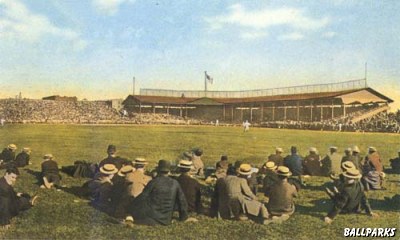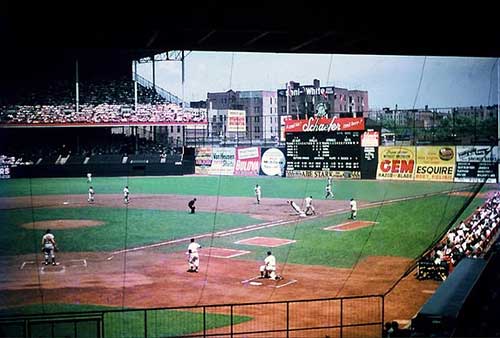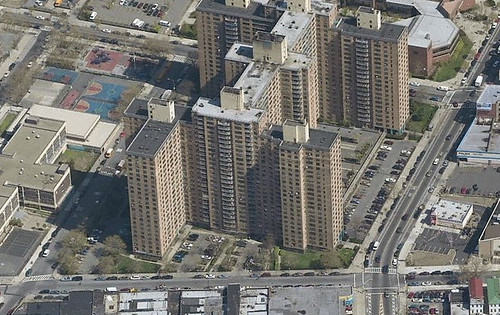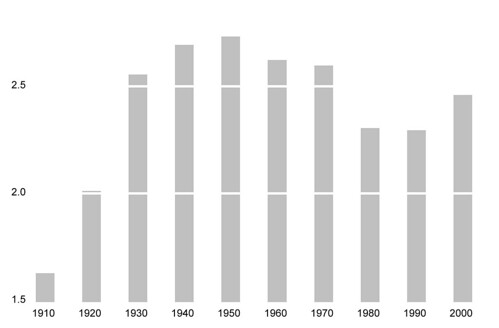trolley dodgers
Once upon a time, Brooklyn was a city of baseball and railroads. Following the construction of the Brooklyn Bridge in 1883, the borough became home to several ballparks and a comprehensive rail network. The traffic near one stadium was so dense that the home team was nicknamed the 'Trolley Dodgers.'
 Washington Park, 1898-1914. This photo is of the 'New' Washington Park at 4th Avenue and 3rd Street, which replaced an older stadium across the street. (More at mlb.com.)
Washington Park, 1898-1914. This photo is of the 'New' Washington Park at 4th Avenue and 3rd Street, which replaced an older stadium across the street. (More at mlb.com.)
Today, Brooklyn hosts only one minor league baseball team and not a single trolley line. I recently made a pilgrimage of sorts to the site of Ebbets Field, where the Brooklyn Dodgers played from 1913 to 1957. Ebbets Field was the beloved home of a renowned franchise, but it was demolished anyway in 1960.
In one sense, the Dodgers' popularity was the cause of the stadium's demise: owner Walter O'Malley realized he could fill a much larger stadium with fans -- he moved the team to L.A. when Brooklyn's government refused to build one for him.
 Ebbets Field (from Project Ballpark)
Ebbets Field (from Project Ballpark)
Ebbets Field was a unique stadium with a rich history. A defining element was the Shaefer's beer sign in right field -- the official scorer would relay hits and errors by lighting letters in the ad: 'h' or 'e', depending on the play. Besides being the venue of the first televised baseball game, Ebbets Field was also site of the most significant moment in baseball: when Jackie Robinson took the field in the top of the 1st against the Boston Braves on April 15th, 1947, it changed the game forever.
 Ebbets Field, from Lost Ballparks, by Lawrence Ritter. This is the corner of Sullivan Place and McKeever Place, near the eastern edge of Prospect Park. Here's a map.
Ebbets Field, from Lost Ballparks, by Lawrence Ritter. This is the corner of Sullivan Place and McKeever Place, near the eastern edge of Prospect Park. Here's a map.
Just one year after the Dodgers won the 1955 World Series, the last of Brooklyn's trolleys were replaced with buses. The very next year, the Dodgers played their last game in Ebbets Field. In 1960, the stadium was torn down to make way for a huge housing development. (The wrecking ball was painted white with red seams.)
 Ebbets Field Apartments (from local.live.com)
Ebbets Field Apartments (from local.live.com)
The demolition of Ebbets Field came at the cusp of an era of great change for Brooklyn. Suburbanization was shrinking Brooklyn's population, and the remaining communities were growing increasingly segregated. Many banks redlined entire African-American neighborhoods, effectively killing the real estate market. Burdened by poverty and neglect, Brooklyn developed a reputation for crime and disorder by the 1970s.
Today, Brooklyn is changing again. The population is growing for the first time since the 1950s and developers are constructing new buildings in virtually every corner of the borough. While the new growth isn't without its problems -- residential displacement and traffic congestion, for instance -- it represents a truly remarkable economic recovery.
 Brooklyn's Population in Millions, 1910-2000
Brooklyn's Population in Millions, 1910-2000
As Brooklyn regrows, there have been calls for both new sports teams and improved transit within the borough.
Before disintegrating into a rigmarole of subsidies, superblocks and heavy-handed design, the Atlantic Yards development looked to be a great opportunity to return professional sports to Brooklyn. Partially financed by Jay-Z and built on a vacant rail yard, the Nets' basketball arena could have been an enormously popular project. Instead, disengagement from the community and a disregard for the existing built environment have made a disaster of the project. (Hopefully, Brooklyn can still save this one at the buzzer.)
 Development model of Nets Arena and surrounding buildings from the Barclays Center website.
Development model of Nets Arena and surrounding buildings from the Barclays Center website.
While the Nets' arena remains controversial, the movement to restore trolley service is virtually dead. Despite several efforts to bring trolleys back to the waterfront -- especially recent efforts to incorporate streetcars into the planning of Brooklyn Bridge Park -- Brooklyn's only remaining trolleys are rusting on a dock in Red Hook.
 Three PCCs in front of the Red Hook Fairway.
Three PCCs in front of the Red Hook Fairway.
There is greater potential for transportation improvements to emerge from a planned BRT demonstration project. While BRT may lack the romance and history of streetcars, it is a practical option to improve Brooklyn's transportation network in the short term. In fact, implementation of a BRT corridor on Nostrand Avenue is slated to begin this year.
Brooklyn, it seems, is evolving from a city of baseball and trolleys into a borough of basketball and buses.
 Washington Park, 1898-1914. This photo is of the 'New' Washington Park at 4th Avenue and 3rd Street, which replaced an older stadium across the street. (More at mlb.com.)
Washington Park, 1898-1914. This photo is of the 'New' Washington Park at 4th Avenue and 3rd Street, which replaced an older stadium across the street. (More at mlb.com.)Today, Brooklyn hosts only one minor league baseball team and not a single trolley line. I recently made a pilgrimage of sorts to the site of Ebbets Field, where the Brooklyn Dodgers played from 1913 to 1957. Ebbets Field was the beloved home of a renowned franchise, but it was demolished anyway in 1960.
In one sense, the Dodgers' popularity was the cause of the stadium's demise: owner Walter O'Malley realized he could fill a much larger stadium with fans -- he moved the team to L.A. when Brooklyn's government refused to build one for him.
 Ebbets Field (from Project Ballpark)
Ebbets Field (from Project Ballpark)Ebbets Field was a unique stadium with a rich history. A defining element was the Shaefer's beer sign in right field -- the official scorer would relay hits and errors by lighting letters in the ad: 'h' or 'e', depending on the play. Besides being the venue of the first televised baseball game, Ebbets Field was also site of the most significant moment in baseball: when Jackie Robinson took the field in the top of the 1st against the Boston Braves on April 15th, 1947, it changed the game forever.
Just one year after the Dodgers won the 1955 World Series, the last of Brooklyn's trolleys were replaced with buses. The very next year, the Dodgers played their last game in Ebbets Field. In 1960, the stadium was torn down to make way for a huge housing development. (The wrecking ball was painted white with red seams.)
 Ebbets Field Apartments (from local.live.com)
Ebbets Field Apartments (from local.live.com)The demolition of Ebbets Field came at the cusp of an era of great change for Brooklyn. Suburbanization was shrinking Brooklyn's population, and the remaining communities were growing increasingly segregated. Many banks redlined entire African-American neighborhoods, effectively killing the real estate market. Burdened by poverty and neglect, Brooklyn developed a reputation for crime and disorder by the 1970s.
Today, Brooklyn is changing again. The population is growing for the first time since the 1950s and developers are constructing new buildings in virtually every corner of the borough. While the new growth isn't without its problems -- residential displacement and traffic congestion, for instance -- it represents a truly remarkable economic recovery.
 Brooklyn's Population in Millions, 1910-2000
Brooklyn's Population in Millions, 1910-2000As Brooklyn regrows, there have been calls for both new sports teams and improved transit within the borough.
Before disintegrating into a rigmarole of subsidies, superblocks and heavy-handed design, the Atlantic Yards development looked to be a great opportunity to return professional sports to Brooklyn. Partially financed by Jay-Z and built on a vacant rail yard, the Nets' basketball arena could have been an enormously popular project. Instead, disengagement from the community and a disregard for the existing built environment have made a disaster of the project. (Hopefully, Brooklyn can still save this one at the buzzer.)
 Development model of Nets Arena and surrounding buildings from the Barclays Center website.
Development model of Nets Arena and surrounding buildings from the Barclays Center website.While the Nets' arena remains controversial, the movement to restore trolley service is virtually dead. Despite several efforts to bring trolleys back to the waterfront -- especially recent efforts to incorporate streetcars into the planning of Brooklyn Bridge Park -- Brooklyn's only remaining trolleys are rusting on a dock in Red Hook.
 Three PCCs in front of the Red Hook Fairway.
Three PCCs in front of the Red Hook Fairway.There is greater potential for transportation improvements to emerge from a planned BRT demonstration project. While BRT may lack the romance and history of streetcars, it is a practical option to improve Brooklyn's transportation network in the short term. In fact, implementation of a BRT corridor on Nostrand Avenue is slated to begin this year.
Brooklyn, it seems, is evolving from a city of baseball and trolleys into a borough of basketball and buses.

3 comments:
That last picture links back to an interesting tidbit: that the very first regular-service PCCs were Brooklyn's. And the PCC was itself a wonderful example of publicly driven common good occasionally winning out over divide-and-conquer commerce. The PCC brought standardization, economy of scale, and great efficiency to urban transit, and did so at the behest of the customers -- the major public-transit agencies in the US, thus PCC: the "Presidents Conference Car". The next phase in public transit appeared to have many of the same attributes, in that the standardized trolleys were replaced by largely standardized buses, but the standard was now promulgated by the supplier -- mostly General Motors -- and not by the customer. Soon planned obsolesence undid all the PCC's gains.
Dodgers are the best team in the MLB, we have great fans, really Los Angeles has great fans we just need to stay up. For example, last week in Los Angeles an associate of mine wanted to watch the Dodgers, so I tried to get him front seats, guess what everything was sold out that show how great our fans are. The prices were really crazy though 2 times the face value. Anyhow I end up getting them face value in the end using this free comparison tickets site through this link
Dodgers tickets
http://www.ticketwood.com/mlb/LosAngeles-Dodgers-Tickets/index.php
Anyhow I though this is something would interest you, GO DODGERS!!!
God bless Baseball
Thanks for the nice post!
Post a Comment